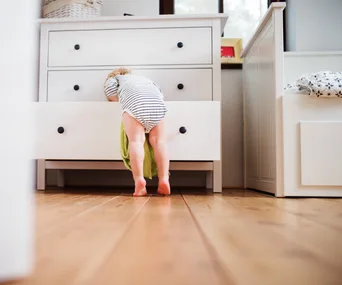The kitchen is the ultimate hotspot of the home – a place for cooking, enjoying family meals and entertaining guests on the weekend. In being the most used space of the house, the kitchen also demands some pretty tiresome cleaning rituals, from the nightly dish wash to the fortnightly fridge clean out.
Despite being the most regularly maintained zone of the house, the kitchen actually has more nasty germs lurking around than the average bathroom, ew! It’s a pretty shocking revelation, but there’s no need to panic. We have hunted down the most gruesome truths about kitchen germs and an array of solutions to match, to help you beat the bacteria crawling in your cooking zone.
1. It’s more hygienic to not clean your mug than wipe it with a kitchen sponge
Damp sponges prove to be the number one kitchen culprit for harbouring some serious illness-causing, nasty bacteria. Milk, eggs, fruit and vegetables can present bacteria in the kitchen, but meat is the common cause of those lingering germs living in your sponge. Avoid spreading nasty germs from dish to dish and give your sponge the deep clean it deserves. Try zapping in the microwave for 30 seconds or soaking in bleach to rid of those pesky germs.
2. Soaking pots and pans in stagnant water is a breeding ground for germs
Fighting tough stairs on pots and pans can prove a difficult task. It’s easy to think that soaking your lasagne dish is the best way to eliminating that grime, but the soaking water can actually create an environment for germs to spread. Instead, scrape dishes and pop into a dishwasher with Fairy Platinum All In One Dishwasher Tablets. The high temperatures of the dishwasher will remove unwanted germs whilst the cleaning agents of the Fairy Tablet will cut through grime and oil. Bonus: the tablets even help to clean your dishwasher filter of limescale.
3. The kitchen sink contains 100,000 more germs than the inside of the toilet
You would think that the cleaning hotspot of the kitchen would actually be the least germ infested zone, right? Wrong! That raw meat juice that you wash off your chopping board and knife is one of the main causes of the build-up of bacteria in the sink drain and disposal. A great way to sanitise is to wash a diluted bleach solution down the drain with hot water.

4. Knife blocks are a hotbed for multiplying mould
Almost every household is home to a knife block – they’re convenient, practical and a safe place to store the sharpest objects in the kitchen. The loved storage solution is just as loved by bacteria, with the pockets an all-too-easy zone for mould and yeast to hide. If you’re looking to invest in a knife block, find one that is dishwasher safe and easy to sanitise. If you already own one, start scrubbing!
5. Salmonella, yeast and mould are living inside your fridge draws
They’re the handy zones of the fridge where you store your fruit and vegetables, but there is a good chance you broccoli is partying alongside some seriously nasty germs. Salmonella, yeast and mould could potentially be contaminating your fresh produce, so getting on top of lingering bacteria in vital. Once a month, remove your draws and wash with warm water and Fairy detergent. It will kill any residue and will again, prove a sanitary storage space.
6. Just because you put your leftovers freezer, doesn’t make them safe to eat
It’s a pretty common go-to, freezing leftovers – whether it’s a Bolognese sauce for next week’s dinner or a take-away curry that you don’t want to waste. Unfortunately, the bad bacteria that grows in food can even survive freezing temperatures. Freezing does not make food safe to eat, as when it’s thawed; bacteria can still be present to multiply. The best way to keep yourself and your littleluns safe is to simply prepare fresh food, or when re-heating, ensure it’s to at least 75 degrees.

7. Chopping boards hold 200 times more dangerous bacteria than a toilet seat
It’s the most used kitchen utensil, but you’re better off chopping your food on the toilet seat than a chopping board. Despite your best intentions, washing the board after every use isn’t the most effective way to rid of those pesky, food-poisoning causing germs. An easy solution is to remember to replace your board regularly and between uses, clean with baking soda and hot water.
Brought to you by Fairy



